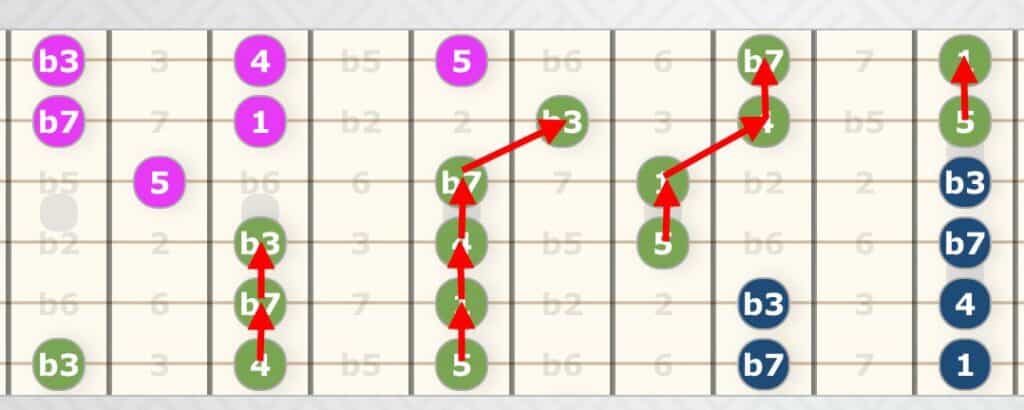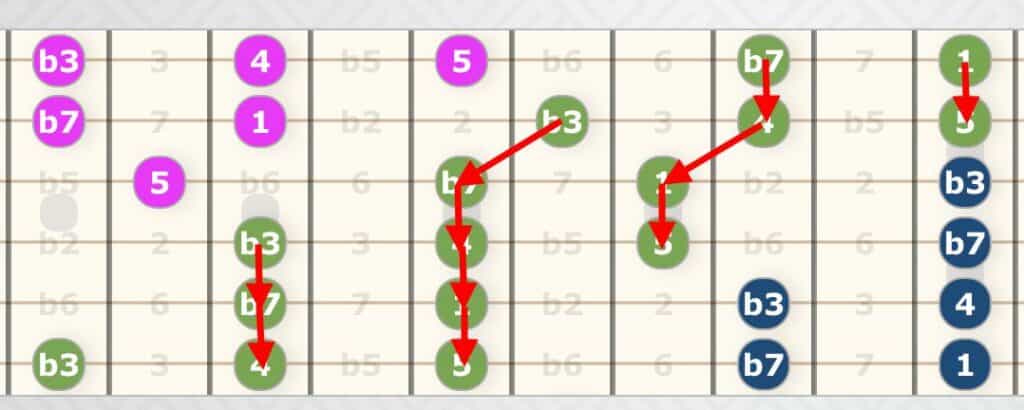
Learn the Pentatonic scale in minutes
No more rote memorization of the 5 patterns. If you can count to 3 you can learn the pentatonic scale quickly and easily using the Fret Hop™ method.100% FREE from FretHop.com. There’s nothing to buy. No ads.

A new approach to the Pentatonic Scale that will have you playing up and down the fretboard within the next 60 minutes or less.
Let me first start out by saying that I am not a musician.
I am not even a good guitar player – I build websites for a living and play guitar for personal enjoyment.
Nonetheless, I enjoy playing and have a strong drive to keep on learning…
And it is this drive that has led me to the fret hop discovery.
Perhaps I am not the first person to figure this out, but I have literally watched hundreds of YouTube guitar videos over the years, and taken many online guitar training courses, and not once have I seen someone demonstrate what I am going to reveal to you.
I am going to skip music theory and keep it simple.
So let’s jump right into the method that has allowed me to go from playing memorized pentatonic shapes – and poorly at that as I move up and down the fretboard — to playing the entire fretboard, with very little thought and lots of confidence.
Now, there is still some thought required, but once you get this down, playing the right notes of the scale becomes so much easier and clearer.
You will be hopping frets and counting to yourself (1,2,3…1,2) instead of memorizing the 5 shapes and positions so commonly taught to get you to learn the pentatonic scale.
And once you learn this pattern, you will LOVE the added BIG BONUS you have also just unlocked, without even knowing it. I’ll show you that too.
So let’s jump right in…
Setting The Stage
THE BASICS
- There are 5 notes in a pentatonic scale.
- These 5 notes are repeated across the fretboard – our goal is to play these notes up and down the fretboard at will.
- We are going to start with the Em pentatonic scale since this is a popular and easy to key to begin with. Now, don’t get confused by the Em key. It’s just a starting point of reference.
- As you will see, the process you will learn applies to any key with ease.
The First Principle
An important observation I made while playing the pentatonic scale is realizing that each note is 1 fret hop or 2 fret hops away on the same string, from the last note played.
I thought that if I can figure out where to hop 1 fret and where to hop 2 frets, I will have unlocked this pattern, since no consecutive notes (on the same string) are on adjacent frets (right next to each other) nor are they more than 2 fret hops apart.
This first principle led me to my first AHA moment…
The 1-Fret Hop.


The 1-Fret Hop

I learned I could partially play the pentatonic scale by playing notes just 1 fret hop apart, and stair stepping the scale on adjacent strings.
I learned of this trick years ago and I’ve seen it to referred to as a “diagonal pentatonic run”.
The diagonal pentatonic run is cool, but it left me confined only to the notes within the run.
I had no clear understanding of how to break free from the diagonal pentatonic pattern, at any time, from any string, to continue playing notes within the pentatonic scale up or down the guitar neck. It overwhelmed me.
But let’s start here as this is the first step.
Here is a diagram of the diagonal pentatonic pattern that I am going to refer to as the 1 fret hop stair stepping pattern — as all notes are 1 fret hop apart.
Look only at the green dots and the red ovals for now:
What you see here is an alternating pattern of 3 one-fret hops, and 2 one-fret hops, played on adjacent strings.
For clarity and consistency, let’s refer to the 3 note pattern as a 3 banger and the 2 note pattern as a 2 banger.
3 banger = 3 consecutive notes on the same string played one fret hop apart
2 banger = 2 consecutive notes on the same string played one fret hop apart
If you look at the diagram above, you will see that since we are in the key of Em, the first full pattern we encounter is a 3 banger on the low E string starting at the 3rd fret.
You play the notes on fret 3 – hop 1 fret – play note on fret 5 -hop 1 fret – and play the note on fret 7.
Next, you move to the A string and play a 2 banger, playing the notes on fret 5 – hop 1 fret – and fret 7.
And then move now to the D string, and play another 3 banger (since we played a 2 banger on the previous string). Play fret 5 -hop 1 fret – play note on fret 7-hop 1 fret – play note on fret 9.
Couple IMPORTANT things to note here:
- The TOP NOTE of the 2 BANGER (note nearest the body of the guitar) is always the ROOT NOTE (in this case it is the E note, since we are using the Em scale).
- When moving from one string to another in sequential order, as in the above diagram, the shift from one string to the next adjacent string is done by playing the same 2 frets last played (except for the B string — moving up the fretboard — & G string — moving down the fretboard — and we’ll get to that too).Here is a diagram to help you see the shift from string to string when playing up the neck…
Moving on, next play a 2 banger on the G string: Play notes on fret 7 -hop 1 fret – and 9.
Next comes the B string and this string always requires special care. To me it is the magic note of the guitar that makes chording possible. Love the B string – don’t hate it 🙂
So the thing to remember when jumping to the B string while moving up the fretboard playing these patterns, is that you will need to start your next pattern FORWARD ONE FRET (towards the body of the guitar).
Also, if you are playing down the neck of the guitar, when you move from the B string to the G string you will need to play the next note on the G string BACKWARD ONE FRET (towards the headstock of the guitar).
So to continue in our example, after playing the 2 banger on the G string (Frets 7 & 9), we would play a 3 banger on the B string starting on fret 8 (instead of fret 7).
So the B string notes would be 8, 10 and 12.
Then you would finish the diagonal pentatonic pattern, playing a 2 banger on frets 10 & 12 on the high E string.
I recommend using the diagram above to quickly get a grasp on this. It sounds wordy trying to describe this process, but when you see what is happening it becomes much simpler to understand.
The 2-Fret Hop
Now the best part – and what will really open up the fretboard for you…

I found that after playing the 2 banger or 3 banger pattern, you could simply hop 2 FRETS ON THE SAME STRING and play the OPPOSITE pattern of what you just played — in EITHER DIRECTION.
This one insight unlocks the entire fretboard.
So let’s look at our 1 fret hop stair stepping pattern again, but time with the 2 fret hops indicated with the red arrows.
Notice that on any string — if you just played a 2 banger, you can hop 2 frets and then play a 3 banger – hop 2 frets and play a 2 banger, and so on. And vice versa if starting with a 3 banger.
And once you have moved up or down a string to the next pattern, you can resume the stair stepping pattern of alternating 2 bangers and 3 bangers on adjacent strings, as noted above with red ovals.
So to play in another key, say Am, just play a 2 banger where the root note (A) is the top note of the pattern.
The BIG BONUS
You are going to love this…
Not only did you just learn the pentatonic scale, but you also took the first step in playing the MAJOR SCALE!
If you PLAY THE TIPS of the 3 Banger – meaning the note on the fret immediately before the 3 banger and the note of the fret immediately after the 3 banger, you will have just played the relative major scale.
Sticking with our Em example, below is the G Major scale.
Add the BLACK notes circled below to Em pentatonic scale you just learned and you now are playing the G Major scale.
The G Major scale includes all of the notes of the Em scale, and includes 2 additional notes (the ones on the tips of the 3 banger)
To change a key, just remember the ROOT NOTE for any major scale is the FIRST NOTE IN THE 3 BANGER PATTERN (in the diagram above this is any note with the number 1 – the note closest to the headstock).
That’s it.
“My hope is that this saves just one person months or years of frustration by being able to play the pentatonic and major scales with a new understanding.”
– Scott Bernadot
Never expected. Always appreciated.







